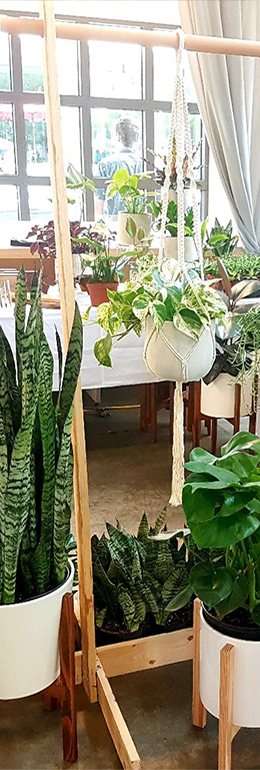Indoor plants, Plant problems and solutions
Why Is My Peace Lily Turning Black? (Causes+Solution)
Belonging to the tropical rainforests of America, Peace Lily is a common houseplant with luscious green foliage and white flowers. However, it is sad and frustrating when these dark green leaves lose their color and turn black.
But why is your peace lily turning black? Let’s find out.
Peace Lily leaves turn black mainly due to fungus infections and pest infestations. Other problems such as improper watering, over-fertilization, and wrong soil also cause black leaves. You need to identify the problem early on and take the necessary steps to save your peace lily plant.
If you want to know what causes black leaves in your Peace Lily plant, keep reading this article. We will also cover information about how to fix these issues and prevent them from further occurrence.
What causes Peace Lily to turn black?
Belonging to the aroid family, Peace Lily needs proper water and humidity. When these plants grow in their natural habitat, they get all their requirements from Mother Nature.
But while growing as houseplants, providing all their requirements that match their native land can be challenging.
Black leaves do not happen in a day. When you keep your plant in an unhealthy condition for a prolonged period, it shows signs indicating that they are suffering from severe issues.
Let us study some possible causes of black leaves in the Peace Lily.
Incorrect watering
Incorrect watering includes both overwatering and under-watering.
Rain is a common occurrence in tropical regions, so these plants cannot tolerate under-watering. If they require water, they start wilting, but they will turn yellow, crisp, and eventually black if you deprive them of water.
Due to lack of water, the roots will remain dry and won’t receive nutrients.
Similarly, overwatering too causes black leaves in the plants. It causes more harm to the plant than under-watering. Overwatering makes the soil soggy, and the roots remain wet. Due to an extended stay in the water, the roots will suffocate and rot.
Unhealthy roots will shut their functioning system and will die. The plants won’t be able to get the nutrients from dying roots.
Poor water quality
Minerals like chlorine and fluorine are harmful to the Peace Lilies. These minerals result in salinization and increased acidity of the soil.
The minerals build up in the potting soil, and the efficiency of the water supply gets weakened. This harmful salt gets absorbed in the water, due to which the roots start getting damaged.
These minerals tend to dislocate all the essential nutrients in the soil, which results in nutrient deficiency.
Because the plant fails to receive nutrients, they start showing signs like yellow and brown leaves, which progress to black leaves.
Fungal infections
Fungal infections cause more black leaves than watering issues do. You need to observe your plant daily to look for the fungus in your plant.
Fungus infections happen mostly when the plant is damp for a prolonged period. Wet soil and leaves create an ideal environment for these fungi.
Many fungal infections can cause black leaves in the plants like Cylindrocladium Root and Petiole Rot, Dasheen Mosaic Virus, Phytophthora Leaf Spot, or Leaf Blight Pythium Root Rot.
Speaking of one, Leaf Blight generally spreads due to the splashing of water. When your plant faces high moisture and high humidity together, it becomes ideal for the growth of this fungus. It slowly turns the leaves black if not treated immediately.
Root rot
When you overwater your peace lily without understanding the right amount or your plant’s soil fails to drain the excess water, your plant develops root rot.
Slowly, the leaves start looking like they are soaked in water and turn black. The potting soil releases a bad foul smell from it.
Black water-soaked leaves and a foul smell are the signs that your plant is experiencing root rot. If you try checking the roots, you will notice that the roots have turned black and mushy.
Cylindrocladium fungus is a common root rot pathogen in the Peace Lilies. When they attack the plant and affect the roots, the leaves change to yellow, brown, and eventually black.
Pests
Another reason for black leaves on your Peace Lily might be unwanted guests like mealybugs, aphids, spider mites, and scales. These plants do not naturally get attacked by bugs, but if they have bugs, it means something is wrong.
You might have kept the soil wet or kept them dry for a long time.
These are all sap-sucking bugs that feed on the plants’ nutrients and leave the plant devoid of nutrients, thus damaging the plant with black spots all over.
Overfertilization
Too much fertilizer, primarily nitrogen, increases the soil’s acidity, due to which chemical imbalance is caused, and the roots fail to absorb the minerals.
Due to excess fertilizer, the root system gets burned; the tips and edges of the leaves start turning black and slowly spread entirely. Over-fertilization starts showing the first signs on the leaves.
Over-fertilization also adds salt to the soil; these salts absorb water and leave the plant dry. Such conditions make it difficult for the plant to absorb magnesium, iron, potassium, manganese.
Due to nutrient deficiency, the plant causes leaf necrosis with black portions on certain parts of the leaves, like the tips, middles, edges; the leaves show burnt signs, it gets wilted. If it is not fixed in time, the plant will end up dying.
Cold injury
The ideal temperature for these plants is between 65-85°F. They cannot tolerate temperatures below 45°F. You must not keep them in rooms with air conditioners.
The root system does not function when they receive extreme cold weather, and the plants cannot transpire and, therefore, suffocate.
The metabolism of the plant deteriorates due to cold, and the leaves start wilting. Slowly the leaves start having black spots on them, and it eventually spreads to the whole leaf, turning completely black due to the shock.
Humidity
Since peace lilies belong to tropical areas, they need high humidity to remain healthy. They cannot withstand dry air for prolonged periods.
If you keep the peace lily in a room, whether you have air conditioners, heat generators, or ovens, black leaves are certain in your Peace Lily. The dry air from these devices increases the transpiration rate, resulting in more water loss than absorption.
It causes the plant to dehydrate, leading to shriveling and black leaves.
Light issues
Peace lilies grow well when they receive indirect sunlight. Direct sunlight will cause sunburn in them. The plant also suffers from a lack of moisture, and the leaves become black due to this stress.
Unlike other plants, this houseplant will grow very well under shade. But that does not mean that they don’t need light. They need light to perform photosynthesis, get energy from the sun, and build up sugar in the plant.
If the peace lily does not get enough light, the leaves will lack the energy to maintain their color, resulting in black leaves. It starts becoming yellow first, and when it gets worse, it becomes black ultimately.
How to fix black leaves in Peace Lilies?
If your Peace Lily has black leaves on them, you need to quickly detect the problem and take action without any delay to help them survive.
We have already discussed the probable causes of black leaves in detail. Now let us read the solutions to those problems.
Water consistently
If you do not want to let your peace lily have black leaves, you should stop overwatering or under-watering. For following a proper watering technique, consistency is essential.
Do not let the soil dry or be soggy. Allow the soil to remain moist but not damp.
If some leaves on the peace lily have turned black due to overwatering, prune those leaves with sterilized scissors. It helps in preventing fungus or bacteria and unnecessary transfer of nutrients to the already affected leaves.
Set up a good drainage
Your pot should have drainage holes to drain the excess water. Also, make sure that the soil has a sound drainage system.
The soil should drain excess water and also retain enough moisture. The best way to save your plant from overwatering is to check the moisture level of the soil.
Insert your finger inside the soil to check the moisture. Another way is by lifting your pot. If your pot feels heavy, it means your plant doesn’t need water yet.
If your plant starts wilting, it means it needs water.
Filter the water
Do not use tap water directly on the peace lily as it contains chlorine which is harmful. They provide dark stains on the leaves. Filter the water to eliminate chlorine, fluorine, and bicarbonates.
If there is no way to filter, let the water sit overnight for 24 hours. It will allow the chlorine to evaporate and make the water less harmless for the plant.
You can use distilled water for good results in your plant. Use room temperature or tepid water.
Rainwater will also work well for the Peace Lilies. So you can also collect rainwater, save it in a container and use it in the future.
Treat the diseases
Remember, there is no guarantee that diseases won’t come back, but you can cure the disease and suppress it.
Use baking soda to get rid of fungus infections. Baking soda works as an excellent antifungal and non-toxic agent. Mix one tsp of baking soda with one liter of water in a spray bottle. Spray it on the affected parts of the plant.
Repeat until the plant gets rid of the fungus traces completely. If pathogens are attacking your plant or the condition is severe, you will need to apply fungicides.
Check the amount and concentration of fungicide prescribed on the label before using it. Before applying these treatments, isolate your plant and get rid of the affected parts to prevent spreading.
Repot the plant
Check the plant closely, and if the root rot is partial, you can save your plant by repotting it. Isolate the plant immediately and get rid of the affected leaves.
Remove the plant from the pot, gently remove old soil from the roots, and cut off the roots that have turned mushy and brown. Let the roots heal by preventing further injury and transplant the plant to a new pot with a fresh potting mix.
New pot and fresh soil mix are recommended because the old ones might contain fungus and bacteria. Make sure to use good quality soil.
Consider using the right pot size. Choose the pot size according to plant size. A too big or too small-sized pot will have harmful effects on your plant.
Withhold watering for a while
The roots are still healing. So, it is better not to water your plant for some days. Let the plant recover from the rotting problem.
Once they get back their strength, you can start watering them. Start with small amounts and then gradually you can increase according to their need. Be moderate.
Get rid of the pests
There are several ways of removing pests.
Rinse the plant
Give your plant a forceful shower to wash away all the pests from the plant. Make sure not to harm the plant with extra force.
Spray homemade solutions
Several homemade solutions will treat pests in your plant. Neem oil is a great solution to treat bugs.
Other solutions are insecticidal soap, dish wash soap, herbs solutions, and baby shampoo. Mix these with water and spray the solution on your peace lily. Some of these solutions will help you get rid of the bugs and treat the affected parts of the plant.
Use insecticides made for specific species
If your plant is affected severely, you must use commercial insecticides made explicitly for the bug species.
Make sure not to overuse these insecticides as they contain toxic chemicals. If you overdo their application, instead of treating, you might end up killing the plant.
While applying these commercial insecticides, bring your plant to some isolated place.
Fixing over-fertilization
To save your plant from over-fertilization, stop fertilizing your plant for some time if you find out any signs of over-fertilizing. Discard the affected leaves.
If your soil has accumulated salts, leach the soil with water to remove all the leftover salts from it.
Ensure that your pot and potting soil have a sound drainage system so that the polluted water can drain out entirely from the soil and pot. Using less fertilizer is much better than over-fertilizing.
Save the Peace Lily from the cold by placing it in a warm location.
If you find signs of cold injury in your plant, immediately remove it and keep it in a warm location. Room temperature will work best for these plants if the room is not having any air conditioner or heaters.
If the leaves are affected due to any bacterial or fungal infection, cut off those leaves. Do not prune the affected leaves immediately. The decayed leaves might help in preventing further injury by separating the plant.
The leaves which get affected due to cold injury get rid of them in the spring or summertime to form new soft tissues at the injured place.
Try to maintain the room temperature between 65 to 85°F. Do not let the temperature fall below 45°F or above 90°F.
Fix the humidity
Belonging to the tropical rainforest areas, they need high humidity to remain alive. They need 50% of humidity. There are several ways of fixing the humidity of your plant.
Grouping plants: You can increase the humidity of your plants by grouping many plants. As the plants transpire, they will release some moisture into the air that will increase the humidity.
Misting: A cheap and effective way of increasing humidity is misting. Misting helps create moisture around the plant. Mist your plant twice a week to maintain the ideal humidity level for Peace Lily.
Use humidifiers: You can keep a humidifier in the room to meet the humidity requirement of the Peace Lilies. If you have more plants other than Peace Lilies, humidifiers are a great choice. The extra moisture will help the plant thrive.
Place the plant under bright indirect light.
Keep the Peace Lilies near a south or west-facing window to give them a good amount of light. Use curtains to filter the direct sunlight so that the peace lily gets indirect light.
You can also place them in the north or east-facing windows as it will not direct the plant.
Use artificial light to help the peace lily receive light if it is not getting enough already. Place the light 6 to 12 inches above the plant for best results.
Preventive measures
We all know that prevention is better than cure. All the points discussed indicate that you can cure your plant and bring it back to life. But it’s better if you can take action beforehand.
Continue reading to know about the preventive measures to save your Peace Lilies from black leaves.
Watering Frequency
Water your plant once a week and distribute water equally over the soil. It will suffice for a whole week.
Water only after making sure that the topsoil is dry.
Choose the suitable soil and pot.
Avoid using clayey or sandy soils. Clayey soil holds too much moisture making the soil wet for long, whereas sandy soil drains excessive water letting the plant stand in drought.
Choose a soil that can retain moisture and drain excess water together. You can poke the soil with a pencil to aerate the soil.
Make sure that, along with the soil, the pot must have a sound drainage system. It needs drainage holes to drain the excess water.
Handmade compost
You can add compost to give your plants good micronutrients. Use the water used for washing vegetables, their peels, and eggshells.
Peace Lilies will grow much better if they receive homemade compost as they do not contain any salts or chemical compounds. They are purely organic.
Match temperature and sunlight.
A warm room with indirect sunlight will give the best results in the plant. Do not keep any heat generators in the room of your plant. Large windows will give ideal sunlight. You can pull off curtains if the sunlight is intense.
Take care of your Peace Lilies and give them proper attention, and you can save your plant from getting any black leaves.

 العربية
العربية

